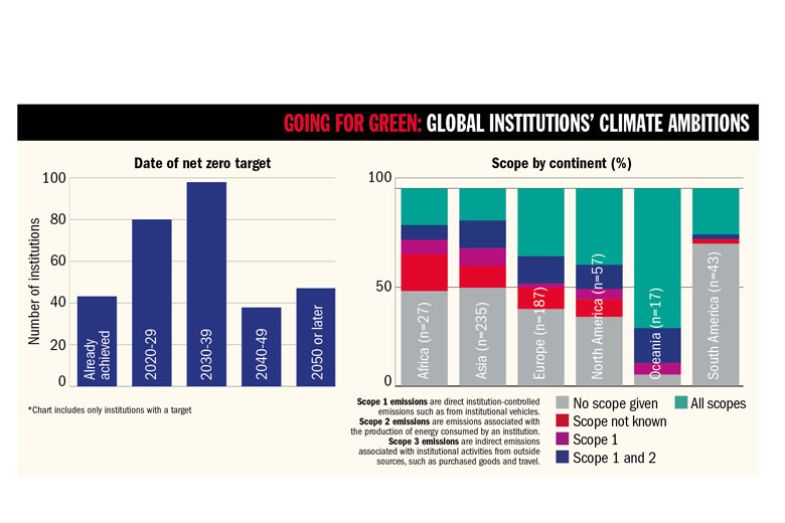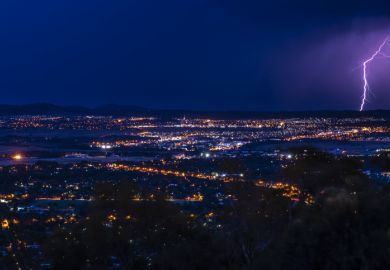Read the THE report, The Race to Net Zero: How global universities are performing
Almost half of global universities that suggest they are committed to taking climate action are yet to set a target date to reach net zero, according to a new report from Times Higher Education.
While more than 550 universities across the world submitted data relating to the United Nations’ Sustainable Development Goal focusing on climate change for the latest THE Impact Rankings, 45 per cent said they had no target to reach net zero emissions under the Greenhouse Gas Protocol (GHGP), a global standard.
Of the 55 per cent that did have a target date, just 49 per cent said this included indirect emissions associated with their institutional activities, such as purchased goods and services or business travel.
The THE report, published ahead of the start of the UN Climate Change Conference (COP26) this weekend, argues that these indirect emissions, known as Scope 3 emissions, are arguably the most important for higher education institutions to measure and reduce, because academics flying abroad to conferences and international students flying to and from host countries produce substantial emissions.
However, even among universities that say they measure Scope 3 emissions, it is unclear how many include international student travel in their calculations. Research from the UK’s COP26 Universities Network that is cited in the paper suggests that the numbers within the UK sector are very low, even though student flights are estimated to account for 18 per cent of the sector’s total emissions. The report finds that universities with a large proportion of international staff and students tend to have more ambitious targets for achieving net zero, but it is not known whether the two factors are related.
 One of the main goals of the COP26 conference is to secure global net zero emissions by 2050.
One of the main goals of the COP26 conference is to secure global net zero emissions by 2050.
The THE report, The Race to Net Zero: How global universities are performing, includes several recommendations for the higher education sector, including creating an agreed framework for measuring emissions from international student travel and setting absolute zero emissions targets, as well as net zero targets.
Net zero means the greenhouse gases entering the atmosphere are balanced by the removal of greenhouse gases from the atmosphere through offsetting. Absolute zero means no greenhouse gases are going into the atmosphere.
Candace Le Roy, executive director of SFU Sustainability at Canada’s Simon Fraser University, said many universities shied away from setting net zero targets because “they imply a formal recognition of the climate crisis and a need to completely transform business as usual, and this will take some big shifts within the institutions that are big unknowns”.
However, she continued, there were enough tools available, including the GHGP, that “all of the universities in wealthier nations should have net zero targets that include all three scopes” and many institutions should be going even further.
“While net zero may be our only option globally, due to the complexity and speed at which we need to act, individual institutions like ours can be more ambitious with an ‘absolute zero’ mindset and action plan whenever possible,” Ms Le Roy said.
“Those of us in developed nations need to focus on getting the emissions down as fast as possible so that there is room for less privileged nations to lean more into greenhouse gas removal and offset projects and a balance can be more equitably achieved globally.”
Most universities that have a net zero target date said they planned to meet the goal within the next 20 years or had already achieved it (71 per cent).
Universities in Australia and New Zealand are the furthest ahead in their commitment to net zero emissions. All but one of the 17 Australasian universities in the analysis have a target date based on the GHGP, 12 are targeting all three emission scopes and seven have already achieved their climate neutral goal or plan to do so by 2030.
Universities in Europe and North America tend to be less ambitious.
However, the research also raises questions about the suitability of the GHGP for the higher education sector and whether the industry needs its own framework. It also notes that institutions that said they did not have a target date may be taking action outside the GHGP.
Iain Patton, chief executive of the EAUC, the UK’s Alliance for Sustainability Leadership in Education, writes in the report that UK universities are “profoundly ill-equipped for the task” of climate action, highlighting an inconsistent approach to emissions scope-setting, measurement and reporting across the sector.
“Not only does this impede institution comparison and collective progress, it is also a risk to our sector’s credibility and reputation,” he says.
The EAUC recently launched a new project aimed at developing a common reporting approach for higher education.
Ms Le Roy added that because universities were “innovation and knowledge mobilisation drivers”, they could “experiment and take risks that other sectors cannot take and then share what they are learning for greater overall impact”.
“Let’s remember that setting targets is not achieving them. That’s just step one,” she added.
“But not having a target that senior leadership is behind is a near guarantee that net zero will not be reached. I’m very proud that our community and leadership is leaning into this work and helping set the bar.”
POSTSCRIPT:
Download the report at https://bit.ly/THERacetoNetZeroReport
Print headline: Green-minded universities fail to set net zero targets
Register to continue
Why register?
- Registration is free and only takes a moment
- Once registered, you can read 3 articles a month
- Sign up for our newsletter
Subscribe
Or subscribe for unlimited access to:
- Unlimited access to news, views, insights & reviews
- Digital editions
- Digital access to THE’s university and college rankings analysis
Already registered or a current subscriber? Login









